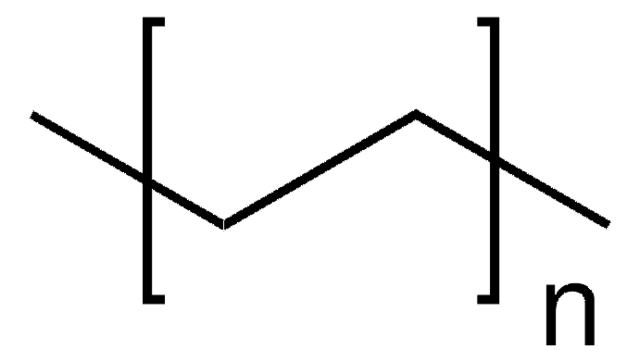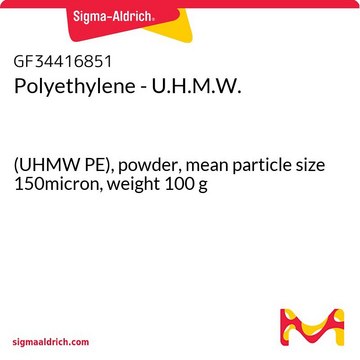547999
Polyethylene
High density, melt index 2.2 g/10 min (190 °C/2.16kg)
Iniciar sesiónpara Ver la Fijación de precios por contrato y de la organización
About This Item
Fórmula lineal:
H(CH2CH2)nH
Número de CAS:
MDL number:
UNSPSC Code:
12162002
PubChem Substance ID:
NACRES:
NA.25
Productos recomendados
Quality Level
form
pellets
melt index
2.2 g/10 min (190 °C/2.16kg)
hardness
65 (Shore D, ASTM D 2240)
transition temp
softening point 123 °C (Vicat, ASTM D 1525)
density
(high density)
InChI
1S/C2H4/c1-2/h1-2H2
InChI key
VGGSQFUCUMXWEO-UHFFFAOYSA-N
¿Está buscando productos similares? Visita Guía de comparación de productos
Application
Typical applications included specialty injection molded parts.
Features and Benefits
Excellent low temperature impact strength and environmental stress-crack resistance.
Storage Class
11 - Combustible Solids
wgk_germany
WGK 3
flash_point_f
Not applicable
flash_point_c
Not applicable
ppe
Eyeshields, Gloves, type N95 (US)
Elija entre una de las versiones más recientes:
¿Ya tiene este producto?
Encuentre la documentación para los productos que ha comprado recientemente en la Biblioteca de documentos.
Los clientes también vieron
Eliandra Mirlei Rossi et al.
Journal of infection in developing countries, 7(3), 229-234 (2013-03-16)
Contaminated sponges might lead to cross-contamination in kitchens since they can transfer microorganisms to surfaces where microorganisms can survive for hours or days and contaminate food. The main objective of this study was to evaluate the transfer and the survival
Morteza Meftah et al.
The Journal of bone and joint surgery. American volume, 95(13), 1193-1197 (2013-07-05)
Ceramic femoral heads produce less wear of the opposing polyethylene than do metal femoral heads in wear simulation studies. This is a matched-pair analysis of the wear of ceramic and metal femoral heads on conventional polyethylene in uncemented total hip
Ingvild Bostadløkken et al.
Ugeskrift for laeger, 175(13), 891-892 (2013-04-16)
We present a case of a 66-year-old woman who had a total knee arthroplasty. Shortly after surgery a 90° rotation of her polyethylene liner took place. The complication was undiagnosed for 1.5 years. To know this problem and be able
Alicia E Leadford et al.
Pediatrics, 132(1), e128-e134 (2013-06-05)
Hypothermia contributes to neonatal mortality and morbidity, especially in preterm and low birth weight infants in developing countries. Plastic bags covering the trunk and extremities of very low birth weight infants reduces hypothermia. This technique has not been studied in
S Strieth
HNO, 61(3), 211-216 (2013-03-08)
Although porous polyethylene (PPE) implants are already used in reconstructive craniofacial surgery, they are still only applied in rhinoplasty when critically indicated. Biocompatibility of PPE implants (pore size ~100-200 µm) can be modified by tissue engineering: coatings with extracellular matrix
Nuestro equipo de científicos tiene experiencia en todas las áreas de investigación: Ciencias de la vida, Ciencia de los materiales, Síntesis química, Cromatografía, Analítica y muchas otras.
Póngase en contacto con el Servicio técnico


